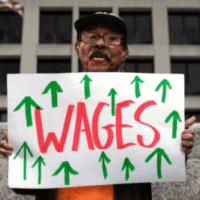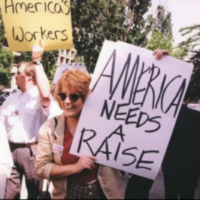This November, Nebraskans will have an opportunity to raise the state’s minimum wage when they head to the polls. Under Initiative 433, the state’s minimum wage would gradually increase to $15 an hour by 2026, with cost-of-living adjustments thereafter. The measure would benefit nearly 150,000 workers, according to estimates provided to NELP by the Economic Policy Institute. Affected workers would see their wages increase by $2,100 annually on average.
Although a higher minimum wage raises earnings for all underpaid workers, women and workers of color would benefit the most, as they are overrepresented among those earning the lowest wages. Thus, a higher minimum wage would help narrow the gender and pay gap and promote greater equity.
Nearly 150,000 workers would benefit from a $15 minimum wage, on average earning $2,100 in additional annual pay
A $15 an hour by 2026 minimum wage would benefit 147,600 workers statewide (16.5 percent of Nebraska’s workforce), according to analysis by the Economic Policy Institute (EPI).[i] Of those, 94,600 are directly affected workers, who earn an hourly wage under $15, and whose wages would therefore increase as the minimum wage increases; and 53,000 are indirectly affected workers, who earn hourly wages equal to or slightly above $15 per hour, and whose wages are expected to also increase as employers adjust pay scales to preserve differences in pay[ii] based on seniority and other considerations.
On average, benefiting workers would earn $2,100 in additional annual pay—an amount that would make a substantive difference in the lives of underpaid workers and their families who struggle to make ends meet (table 4). An additional $2,100 per year translates to $175 per month—enough to fully cover the average monthly electricity bill in Nebraska,[iii] or nearly 45 percent of the cost of monthly groceries for a single mother and her infant child.[iv]
Workers in rural Nebraska[v] would similarly benefit. According to EPI, 17.8 percent of the rural workforce (63,900 workers) would benefit, including 41,000 who would be directly impacted and 22,900 who would be indirectly impacted. These workers make up 43 percent of all impacted workers in the state. On average, they would earn $2,200 in additional annual pay. (Table 4).
The typical affected worker is an adult woman who lives in or near poverty, works at least 20 hours per week in the retail, restaurant or healthcare and social assistance industries, and has a family income of less than $50,000 per year
As shown below and in table 4, the typical worker who would benefit from a $15 minimum wage is an adult woman, as demonstrated not only by age (75 percent of affected workers are aged 20 or older), but also by educational attainment (32 percent have a high school diploma, and an additional 43 percent have attended college). In addition, these workers work at least 20 hours per week (78 percent work 20 hours or more per week). Significant shares of benefiting workers are also workers of color, parents to dependent children, live in or near poverty, and are concentrated in service jobs offering the lowest pay.
The benefiting workforce has the following demographic characteristics, according to EPI’s analysis:
- Age: 75 percent are adults and only 25 percent are teens 19 and under.
- Gender: 61 percent are women. (See following sections for a more detailed analysis).
- Race: 77 percent are white, reflecting Nebraska’s racial makeup. Nonetheless, workers of color benefit more as a result of their overrepresentation in underpaid jobs. (See following sections for a more detailed analysis).
- Parental status: 21 percent are parents.
- Work hours: 40 percent work full-time (35 hours or more per week); 38 percent work mid-time (between 20 and 34 hours per week); and 22 percent work part-time (under 20 hours per week).
- Education: 32 percent have a high school diploma; 43 percent have attended college, including 8 percent who graduated with a post-secondary degree. Only 26 percent have less than a high school diploma—closely tracking the share of teens referenced in the first bullet point above.
- Family income: 54 percent have family incomes of less than $50,000 per year.
- Poverty status: 55 percent live in or near poverty.
- Industries: 59 percent work in the retail, restaurant, and healthcare and social assistance industries.
[1]. Economic Policy Institute analysis of Current Population Survey Outgoing Rotation Group (CPS-ORG) (email communication, June 17, 2022).
[2]. Economic Policy Institute, Minimum Wage Simulation Model. See Technical Methodology by Dave Cooper, Zane Mokhiber, and Ben Zipperer, https://www.epi.org/publication/minimum-wage-simulation-model-technical-methodology/.
[3]. Electricity Local, Residential Electricity Rates & Consumption in Nebraska, https://www.electricitylocal.com/states/nebraska/. Accessed August 19, 2022.
[4]. NELP analysis of the U.S. Department of Agriculture, Official USDA Food Plans: Cost of Food at Home at Three Levels, U.S. Average, June 2022, https://fns-prod.azureedge.us/sites/default/files/media/file/CostofFoodJun2022LowModLib.pdf. Accessed August 19, 2022. Refers to the total of the monthly cost of groceries for a woman 19-50 years of age ($248.60) and a 1-year-old child ($149.90) under the low-cost plan, divided by $175.
[5]. For the purpose of this analysis, rural Nebraska is defined as all counties in the state, except for Douglas, Lancaster and Sarpy.




